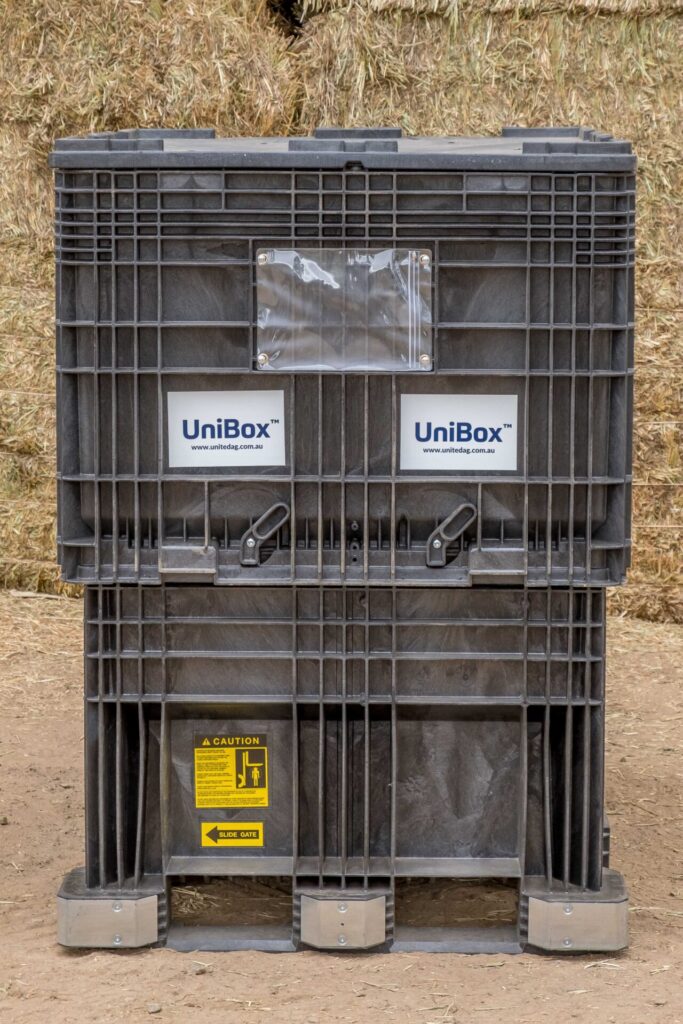



Article by: Hari Yellina
The UniBox is a basic product with a simple design, but the safety it provides has made two Queensland farmers sing its praises. Products that flow, such as grain, seeds, and granules, can be transported and stored in 0.43 to 1.36 tonne loads, depending on box size. Tim McFarlane, director of United Ag in Australia, said the boxes’ heavy-duty structure made them a logical, reusable alternative to bulk bags. “The units are made of high-density polyethylene and have the option of a stainless-steel bottom plate,” Mr McFarlane said. “They entirely shut with a secure lid, providing excellent protection from pests, pollutants, and weathering.”
“Storage is straightforward because they stack and nest for efficient space utilisation, and they come in a variety of capacity sizes.” The inside of the box, according to Mr McFarlane, was smooth and sloping, with the centre exit designed to rapidly and fully drain the contents. He claimed that flow out could be adjusted fast for measuring or mixing. John Ford, a Queensland cane farmer, has three UniBoxes that he uses to spread fertiliser over 162 hectares at Curra, north of Gympie. He believes the device is a far safer and more convenient alternative than bulk sacks. Mr Ford uses a 2t capacity side dresser to apply roughly 120 tonnes of fertiliser to the crop each year.
Fertilizer is delivered to the farm in bulk bags, which he used a forklift to load straight into the dresser’s hopper. He now divides it into three UniBoxes before loading it into the spreader in the pasture. Mr Ford stated, “Standing near or under a bulk bag swinging on the forks is simply not safe.” “It’s not only safer with the UniBox, but it’s also more efficient, quick, and accurate. “We can have all three ready to go, then take them out to the dresser and load them up right there. “Because the forks are hidden beneath the box, it’s lot more solid and lower to the ground.”
Mr Ford said he is frequently questioned why he goes to the trouble of emptying large bags into cartons. “Shifting the fertilisers into the ground boxes only takes a few minutes, but the overall time savings – and safety – makes it more efficient in the end,” he said. “We had trouble lifting the bulk bags high enough to empty into the hopper, and there’s no way to regulate the flow because you have to empty them completely.” “We can fully load the hopper each time we stop with the UniBox, and this is where the time savings really start to add up.” Steve Swan, a Queensland beef producer, has also switched to the UniBox.
Mr Swan’s 4452ha ranch in Moura is home to 2400 Droughtmaster cattle. To supplement grazing, the cattle are provided additional diets. Previously, he had been using a forklift to mix the supplies from bulk sacks. “I once witnessed the failure of a hoisted bulk bag in which all four attachment loops detached from the bag at the same time, with no warning.” Mr Swan described the experience as “extremely worrisome and confronting.” “The producers advise against standing beneath a bag, but that’s easier said than done. “It frightened me so much that I devised a mechanism for someone to release the chute on a bag from a safe distance, but it wasn’t perfect.”
Mr Swan stated that he was still looking for a means to deliver ration feed into the TMR mixer in a safe, efficient, and cost-effective manner. He also didn’t want to invest in pricey batching equipment because his business was so small. Instead, he discovered the Unibox, which Mr Swan now employs for storage and distribution. He intends to purchase four to six more units and phase out bulk bags entirely. “We can fill them straight via auger,” he explained, “so it’s an easy operation for each item.” “We lift the box to the TMR mixer’s top, release the ration till the scales display the correct quantity, and then turn it off. “If I need to, I can accomplish it on my own using this method.